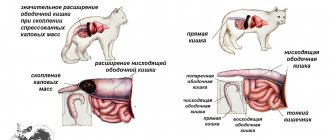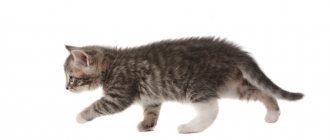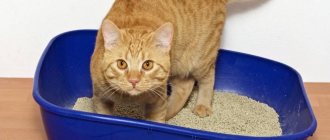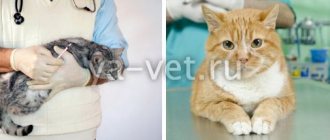As a rule, owners have a lot of worries and worries if something is wrong with their pet. Being attentive and responsible, they will immediately try to find the reasons for unpleasant changes in the health of their beloved cat. Fortunately, most pet owners constantly take care of their pets, and detect problems in the early stages, when it is possible to completely stop the developing disease. At the same time, owners often panic in vain. But if you don’t contact a veterinarian in a timely manner when, for example, a kitten has bloody diarrhea, it is unknown what this could mean for the animal.
Causes of pathology
When cleaning up the pet's potty, the owner may discover that there are several drops of blood on the feces, or that the entire mass of feces is colored reddish. Let us note right away that this is not normal, and such a signal indicates that the animal needs increased observation and attention from humans.
If blood was detected in the stool of a furry pet once, the symptom did not recur again, and the general condition of the animal is assessed as good (that is, the pet is cheerful, cheerful, eats, actively responds to affection), there is no need to worry. Most likely, there was a one-time injury to the animal’s rectum (for example, the mucous membrane could have been scratched by a sharp piece of undigested food or a small foreign object that came out naturally).
If blood appears in the stool again and again, you need to find out the reason for its appearance immediately. In a situation where bloody spots in the animal’s feces are accompanied by such manifestations as lethargy or lethargy of the pet, diarrhea or constipation, refusal to eat, increased or decreased body temperature (the norm for an adult cat is within 38-39 degrees), you need to take the pet to the clinic immediately.
The determining factors due to which a cat goes “out of need” with blood for some time are mainly the following:
- intussusception;
- gastroenteritis;
- stomach ulcer;
- helminthic infestation;
- dysbiosis accompanied by constipation;
- vascular diseases;
- bacterial infection;
- injury to the anus or intestines;
- allergic reactions;
- blood clotting failure;
- foreign objects;
- severe intoxication (when chemicals enter the body);
- benign and malignant tumors.
Blood in your cat's stool is most often caused by irritation in the lower intestine. In addition to the symptoms of hematochezia, allergies and food intolerance can be caused in pets by ordinary food, most often dry food from a dubious manufacturer.
If your cat spends most of its life in the yard or on the street, then it may have been poisoned by rat poison, then bloody stools are a common occurrence. Also, if you notice very hard and extremely dry stools in your cat, then these are clear signs that the animal has nutritional problems.
Among other things, parasites, E. coli, bacteria, worms and other agents carrying viruses of various etiologies can also cause diseases accompanied by bloody feces. Therefore, always, as a caring owner, make sure that your beloved cat does not eat just anything, anywhere, but eats normally and drinks plenty of fluids.
Diagnosis of the causes of bleeding in cats
The cat often goes to the toilet a little at a time
Helping a cat not go to the toilet with blood can only be done by eliminating the cause that caused the damage and treatment aimed at tissue regeneration. Only a veterinarian can select the appropriate therapy after conducting a comprehensive examination of the patient.
The doctor begins the appointment with an analysis of the person’s complaints that the kitten is pooping with blood, then he needs to obtain the most complete information about the living and nutritional conditions of his patient:
- Diet. The veterinarian needs to know whether dry or natural food predominates in the animal’s diet. How often and in what form does it receive vitamins? Additionally, the possibility of your pet eating bones is clarified. It is determined that there is free access to clean water.
- Infestation with parasites. Disturbances in the functioning of the digestive system often occur with helminthiasis, so the doctor needs to know the date of the last treatment. When planning an appointment with a veterinarian, it is recommended to clarify the name of the drug that was given to the cat to remove parasites.
- External condition. When cleaning the skin, long-haired animals can swallow lumps of hair, which sometimes injure the mucous membrane when passing through the intestines. High temperature, mucous discharge from the nose or eyes, lethargy may indicate the development of an infectious pathology. Bleeding that does not stop at rest, or an animal’s acute reaction to touch can become a signal of serious damage to the intestines, including as a result of cancer.
- Access to dangerous objects. The animal's tendency to check the trash can, play with unfamiliar things, climb into the most unpredictable places, and gnaw on plants is clarified.
- Going outside. Walking in the fresh air without control from the owner allows the animal to hunt, try different foods, even drink from puddles. All this leads to infection of the body.
- Associated symptoms. Temperature, appetite, and general condition can tell the veterinarian what caused the pathology.
The general condition of the cat can tell the veterinarian what was causing the concern.
A personal examination of the animal and a veterinarian interview with its owner is not enough to make a diagnosis. To find out the reason why kittens poop with blood, additional blood tests are prescribed, biochemistry, and laboratory testing of feces and urine are performed. Instrumental diagnostic methods are also used, including x-rays, ultrasound and colonoscopy.
If chronic inflammation in the intestinal tissues or tumor formation is suspected, the veterinarian resorts to a biopsy method. Taking a small piece of tissue for research is a painful procedure, so access to it is recorded quite rarely.
When to take your pet to the doctor
You should contact a veterinarian with your cat in the following cases:
- This is not the first time that scarlet blood has appeared in the cat’s stool, and its amount is clearly more than a drop;
- the cat meows or howls when defecating;
- during the process of defecation, the animal is clearly tense; it is impossible to poop without pushing;
- The pet often goes to the toilet to poop (normally – 1-2 times a day).
These manifestations are often accompanied by additional symptoms:
- decreased appetite;
- diarrhea with vomiting;
- increased frequency of urination;
- lethargy, apathetic mood of the pet;
- pronounced thirst;
- sudden weight loss;
- the cat runs its butt on the carpets (a sign of problems with the anal sinuses).
With these signs, you also need to observe how many times a day the cat walks around, how often there is blood and how much of it, whether there are other foreign impurities (mucus, remains of fur or undigested food, etc.). You also need to pay attention to the cat’s behavior and mood, how he eats, how much he drinks, whether there is vomiting and fever. You will need to tell the veterinarian about all this when your pet comes in for an appointment. This will help speed up diagnosis and initiation of treatment.
It is not at all necessary (and even impossible) that all of these symptoms will appear simultaneously. The manifestation of at least one of them, together with the blood that appears in the tray, is enough to show the pet to a qualified veterinarian. It is worth remembering that bleeding from the anus can cause the death of a cat quite quickly!
How to accurately diagnose the disease
Only a veterinarian can identify the exact reason why a cat is bleeding profusely. The animal owner’s task is to help the specialist collect anamnesis. During the consultation you will have to answer the following questions:
- what does a pet eat?
- does he go outside?
- whether there are poisonous plants or other substances hazardous to health in the house that the cat could reach.
The veterinarian will ask how often your pet poops with blood in it and if there are any other warning signs. For example, constipation, diarrhea, poor appetite, depression. During the examination, the cat's temperature is taken.
To establish the exact cause of blood in the stool, additional research will be needed:
- analysis of stool, urine and blood (general, allergen and biochemical);
- Ultrasound of internal organs;
- X-ray of the intestine;
- colonoscopy;
- If tumors are detected, a biopsy will have to be done.
What to do before visiting a doctor
If the animal's condition and behavior are satisfactory, and there are no accompanying symptoms or they do not cause concern (for example, one-time diarrhea or constipation against the background of general health), the cat owner can take some actions before going to the veterinary hospital.
These measures include:
- Treating the animal against intestinal parasites (deworming). To do this, you need to purchase a specialized drug with an extended spectrum of action from a pet store and give it to the animal according to the instructions. If dead parasites appear in the cat’s feces within 24 hours, deworming is carried out again after ten days, monitoring the pet’s condition.
- Normalization of diet. The cat needs to be switched to a balanced diet; the easiest way to do this is to opt for ready-made dry food of the “holistic” class. They will provide the animal with all the necessary substances and elements; in addition, such food is hypoallergenic and safe.
- For long-haired cats – cleansing the intestines of hairballs. To help your pet get rid of them, it is enough to purchase a special paste. You can consult with the seller at the pet store. The paste is given to the animal according to the instructions, usually on an empty stomach (a couple of hours before feeding) twice a week.
How to help your cat yourself
The difficulty of emergency home care is that it is highly undesirable to give your pet any medications before taking tests. Under their influence, the clinical picture may become blurred, and making a correct diagnosis will be difficult. But if it is not possible to urgently take your pet to the clinic, you should still try to alleviate his condition.
If you want to help a sick pet, take him to the clinic
What every owner can do in order not to harm, but at least somehow help the animal:
- provide peace to the sick pet by placing it in a warm, draft-free room on a bedding surface;
- intramuscularly administer pain-relieving antispasmodic drugs (No-shpa, Baralgin), which will relieve pain;
- exclude all solid foods from the diet, instead offer liquid food, easily digestible food, water - without restrictions;
- to disinfect the urinary tract before going to the doctor, give the cat decoctions of bearberry, parsley root, furadonin;
- Inflammatory products are removed from the urinary tract using a decoction of juniper and horsetail.
Treatment of a cat if blood is detected in the stool
The therapeutic plan is drawn up taking into account the cause of the disease. Treatment in a veterinary clinic is required only for animals in serious condition. In most cases, a cat needs to be treated with medications, and the owner needs to ensure that the pet not only takes medications in a timely manner, but also has high-quality nutrition during this period.
Important! If malfunctions of the pancreas or liver are detected, the cat is recommended to follow a diet and take medications with enzymes, for example, Pancreatin.
The main reasons why a cat pees blood
It is necessary to understand that hematuria is only a symptom, not a disease. Therefore, without finding out why the cat is peeing blood, it is useless to start any treatment. Conventionally, there are two types of hematuria: microscopic (when blood cells in urine are visible only under a microscope) and macroscopic (urine has a characteristic scarlet color).
The main reasons that provoke deviation:
- stones in the kidneys;
- tumors of the genitourinary system;
- glomerulonephritis;
- injury, fall from a great height;
- bleeding disorders;
- thrombocytopenia;
- poisoning by rat poison;
- infectious diseases;
- the presence of malignant or benign tumors;
- taking certain medications.
If a cat falls and pees blood, then it is likely that the bladder is damaged. A particularly dangerous situation is when thick, bloody mucus leaks from the urethra. This condition can result in the death of your pet, so you should seek veterinary help immediately. You may also notice that the cat pees blood “a little bit at a time” after removing the urethral catheter. The problem usually disappears after the animal urinates for the first time on its own. Otherwise, a bacterial infection should be suspected.
About 20% of cases of hematuria in cats have an unknown cause. If the veterinarian was unable to identify the real trigger, then a diagnosis of “idiopathic cystitis” is made.
Preventive actions
To keep your pet healthy, you need to take care of it by following simple measures to prevent possible diseases. You can prevent the occurrence of pathological conditions in which blood appears in your cat’s feces by taking into account the following animal care tips:
- keep medicines, chemicals and toxic substances out of reach;
- when choosing ready-made dry food, take into account the age, weight and health status of the pet;
- when feeding dry granules, provide the cat with free access to water and change it in a timely manner;
- carry out timely treatment of your pet against parasites;
- Take your cat to the veterinarian regularly for preventive examinations.
If you notice bloody stools, treat your cat promptly to prevent the appearance of a malignant tumor, intestinal cancer and blood clotting disorders - one of the most common diseases in most purebred cats.
Collecting urine for analysis
If the owner notices bloody urine in a cat, the first thing he should do is take a urine test to diagnose the disease.
A simple option for collecting material for analysis:
- The tray is cleared of filler.
- Cleans well with boiled water (do not use chemicals!).
- Then you just have to wait for the pet to go to the toilet.
However, most pets will only go to the litter box if there is litter in it. In this case, it will not be possible to collect the liquid. Therefore, owners will have to resort to small tricks.
- You can try to watch the animal and, as soon as it settles into the tray, place a clean saucer or small bowl under it. The collected liquid is poured into a clean container and taken to the laboratory.
- You can buy a special kit at a pet store: it consists of pellets for the potty and a container for urine. This filler does not have an absorbent effect.
- You can use small aquarium pebbles as soil for the tray, preferably unpainted. You can find glass cabochons on sale that are also suitable. After the cat has done its business, the urine is collected with a sterile syringe, poured into a container and taken to the laboratory.
In severe cases, with complete obstruction of the urethra, the cat should be immediately taken to the veterinarian. He will insert a catheter, drain any accumulated urine, and collect it for analysis.
The material must be delivered for research immediately, as it quickly loses its freshness. This must be done within 4 hours.
Urine with blood
How is the treatment carried out?
Effective medications
Treatment is prescribed depending on the type of parasite, for example, a frequently used drug is Pyrantel.
If blood impurities during a cat's toilet visit are caused by helminthic infestation, it will be necessary to identify the type of parasites. Then the doctor prescribes a course of treatment, which is based on eliminating the specific pathogen. Often prescribed:
- "Kaniquantel";
- "Dirofen";
- "Febtal";
- "Pyrantel".
If the problem is caused by intoxication of the body with poisons, a specific antidote is administered to the cat. When no more than 3 minutes have passed after consuming this substance, the owner can provide first aid to the animal, which consists of inducing vomiting. For these purposes, it is recommended to add 50 ml of peroxide to 100 milliliters of water. The solution is given depending on the cat’s body weight. For 1 kg of weight there are 2 tsp. solution. After vomiting has been induced, use activated charcoal or Enterosgel.
After 3 hours, you should give the cat a laxative. It is permissible to use castor oil.
If colitis is observed, resort to the antibacterial drugs Tylosin and Metronidazole. Anti-inflammatory pharmaceuticals are also used, for example, Sulfasalazine. It cannot be done without maintenance therapy. For these purposes, vitamin and mineral complexes for animals are prescribed.
Traditional treatment
In combination with classical treatment, it is recommended to give your pet mint infusion, which is taken before meals.
In combination with medications, it is permissible to resort to the help of healers’ recipes. One of the most useful is mint infusion. To prepare it, you will need to take 1 tablespoon of the plant, add 500 ml of hot water and leave for half an hour. The infusion is given to the cat once a day before eating. Dried fruits, for example, prunes and dried apricots, will also help improve digestion.
The right approach to nutrition
Veterinarians from the Zoovet clinic recommend that owners of animals who have blood after going to the toilet switch their cats to natural food. Your pet should be given boiled lean meat, buckwheat, eggs and vegetables. It is important to exclude fermented milk products from the menu. It is permissible to return to industrial complementary foods after the cat’s condition has completely normalized and a course of therapy has been completed.











